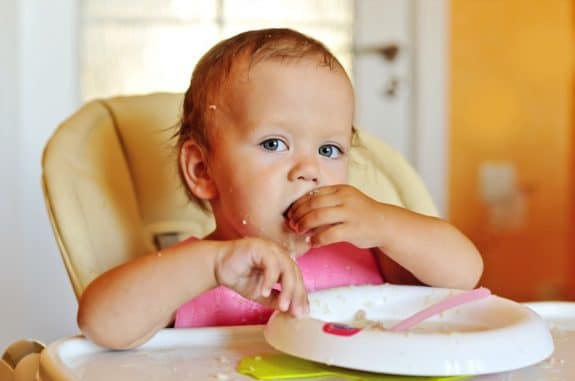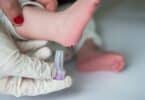There are many different ways to wean a baby onto solid foods. Parents who choose the “baby-led” method should be able to rest easy after a new study determined that it does not increase the risk of choking – as long as certain “rules” are adhered to during the weaning process.
The “baby-led” bucks the traditional way of moving baby toward solid foods. Gone are the messy rice cereals and pureed carrots. Instead, parents introduce soft finger foods and let their baby feed themselves. Some favor this method because it lets the baby control how much they eat which could, in theory, reduce their overall risk of obesity. This method is also thought to improve motor skills and result in babies that are less picky eaters.
There is no actual evidence to prove any of the theories about baby-led weaning hold any real weight. However, there are studies that have shown bottle fed babies have a higher risk of obesity. Researchers from that study suspected that the increased risk may be due, in part, to a parent’s propensity for pushing the baby to finish the bottle. In contrast, breastfed babies typically determine when they are full. Again, this does not serve as proof, but it does lend to a plausible benefit of baby-led weaning.
Still, there have been some concerns over whether or not baby-led weaning might increase the risk of choking for infants since they are still new at the solid food concept. Researchers from New Zealand’s University of Otago sought to determine an answer to this question with a study on 206 moms and infants. Each were randomly assigned to wean their babies with either the traditional method, or with the baby-led version.
If in the latter group, parents were given instructions and education on how to safely feed their babies – babies should be able to sit up on their own, and the foods needed to pass the “squish test,” meaning the foods could be easily squashed on the roof of the mouth. So, soft and well-cooked fruits or vegetables would be acceptable, but most raw foods and foods that contained seeds were off the table. Researchers also gave a strong recommendation to wait until the baby was at least six months of age. All parents were told they should always supervise their babies while eating.
In the end, the risk of choking was not found to be any higher for babies who were allowed to feed themselves. Choking was an issue, however, for about 35 percent of all babies. Researchers highly suspect this may have something to do with the introduction to “risky” foods, which were given to more than half of all babies by the age of 7 months and nearly all babies by the age of 12 months. Hard crackers and raw vegetables were among the highest offenders.
“We were surprised that so many babies were being offered foods that could pose a choking hazard,” Rachael Taylor, a research associate professor at the University, told Health Day. She added that this suggests that parents need more information on how to introduce solid foods, and that “they also need education on the importance of always being with their child when they’re eating, and knowing what to do if their child chokes.”
Dr. Anthony, Porto, a pediatrician who did not participate in the study, agreed. He suggested that all parents take an infant and child CPR class, which would help them know what to do, should their child ever choke. And it’s not just food that is a risk – toys, random items that new crawlers find on the floor laying around the house, and other items in the baby’s environment also pose a risk. He also brought an additional concern on baby-led weaning that parents and pediatricians may initially miss when reviewing the recent study’s conclusion.
“This was carefully designed, and families were well-supported through the process,” he said. “So I’m not sure how reflective this is of what parents are doing in the ‘real world.’”
In other words, parents should really talk to their pediatrician if they plan to use the baby-led method – and not just because they need to fully understand the importance of choosing the right foods and always monitoring their babies. Parents also need to think about the nutritional value of the foods they are giving.
Breast milk does not contain a lot of iron, which is why most pediatricians will recommend introducing a solid with iron in it (such as iron-fortified baby cereal or pureed foods containing meat). In an earlier study, the baby-led infants did have lower intakes of iron, but also zinc and B12. There’s no evidence to suggest they had nutrient deficiencies, or that this lower intake has any lasting effects, but it is something that parents should be mindful of when using the baby-led method.
“You should do what’s best from a safety standpoint, an allergy standpoint, and a nutrition standpoint,” Porto said.







